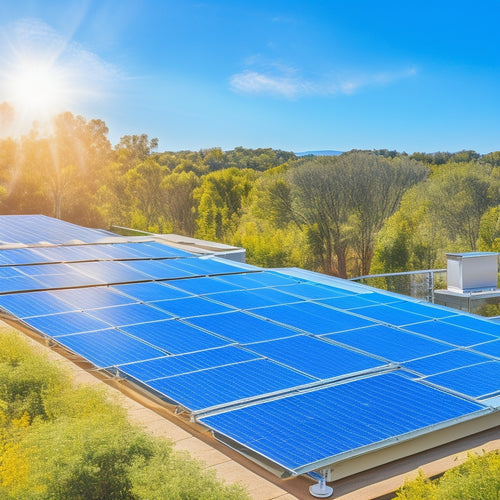
Wall Batteries
Share
As you consider wall batteries, you'll find they provide a convenient, space-saving way to integrate power storage into your existing setup, streamlining your access to renewable energy and freeing up significant floor space. They're designed for space efficiency without performance loss, allowing integration with solar panels for excess energy storage. With advanced battery technology, you can enjoy longer power backup times, reducing replacement frequency and maintenance costs. High-capacity lithium-ion cells enhance energy storage solutions, and checking wattage and voltage ratings is essential for safe operation. Now, uncover how these features come together to optimize your energy storage.
At a Glance
- Wall batteries offer space-saving power options, streamlining renewable energy access and providing clutter-free experiences in small spaces.
- Advanced battery technology in wall batteries enables longer power backup times, reducing replacement frequency and maintenance costs during emergencies.
- High-capacity lithium-ion cells in wall batteries provide significant advancements in energy storage, with high cycle life and minimal energy loss.
- Wall batteries can be designed to seamlessly blend into home decor, with compact and sleek designs available for various needs and energy storage capacities.
- Wall batteries enhance power resilience, allowing integration with renewable energy sources and smart home compatibility for easy energy management and monitoring.
Convenience in Small Spaces
You're likely familiar with the challenges of finding space for power storage in cramped areas.
With the rise of All in One Solar Power Systems, homeowners can now enjoy a more streamlined approach to renewable energy.
Wall batteries offer space-saving power options that can be seamlessly integrated into your existing infrastructure, allowing for a more efficient use of space.
Space-Saving Power Options
In compact living spaces, every inch counts, and finding room for bulky power banks or charging stations can be a challenge. That's where wall batteries come in – designed to provide space-saving power options that maximize convenience in small spaces.
You need solutions that offer space efficiency without compromising on performance. In addition, with the rise of renewable energy systems, homeowners are looking for ways to optimize their energy storage, and wall batteries can help accomplish that goal Home Solar Battery.
By integrating wall batteries with solar panels, homeowners can store excess energy generated during the day for use during periods of low production or grid outages. Modular design enables wall batteries to be seamlessly integrated into your existing setup, providing a clutter-free experience.
With wall batteries, you can say goodbye to tangled cords and lost charging cables, freeing up significant space for more important things. By mounting them on your wall, you're not only saving floor space but also keeping your devices charged and ready to go.
This innovative approach to power storage guarantees you have the freedom to live life on your terms, without being held back by limited power options. With wall batteries, you can stay connected, stay powered, and stay free.
Compact Design Solutions
Frequently, compact living spaces require innovative storage solutions to optimize available space. As you consider wall batteries, you're likely looking for ways to maximize your space while maintaining a sleek, modern aesthetic. Compact design solutions can help you achieve this goal.
Innovative materials and clever design enable wall batteries to blend seamlessly into your living space. For example, you can choose from a range of slim, wall-mounted batteries that can be easily concealed behind artwork or decorative panels.
Here's a comparison of some popular compact design solutions:
| Design Solution | Dimensions | Capacity |
|---|---|---|
| Slim Wall Mount | 12" x 24" x 3" | 5 kWh |
| Compact Vertical | 18" x 36" x 4" | 10 kWh |
| Hidden Panel | 24" x 48" x 2" | 15 kWh |
| Folded Design | 30" x 60" x 5" | 20 kWh |
Longer Power Backup Times
You're looking for wall batteries that can provide extended power backup times, and that's where advanced battery technology comes in.
With the rise of renewable energy storage solutions, homeowners can now enjoy longer periods of backup power during outages off-grid systems.
By opting for wall batteries with extended battery lifespans, you'll experience fewer replacements and reduced maintenance costs.
Additionally, enhanced power resilience guarantees your critical systems stay online during outages, giving you peace of mind.
Extended Battery Lifespan
By opting for wall batteries with extended lifespans, you're ensuring your important devices stay powered on for longer periods during outages, thereby minimizing downtime and potential losses.
This means you'll have more time to focus on what matters most - staying connected, productive, and safe - without worrying about your power backup running out.
To maximize the lifespan of your wall battery, it's important to follow proper battery maintenance tips.
This includes avoiding extreme temperatures, keeping the battery away from moisture, and ensuring it's installed in a well-ventilated area.
Additionally, adhering to charging frequency recommendations is significant. Overcharging can reduce the battery's lifespan, so it's crucial to charge it only when necessary.
Enhanced Power Resilience
Your wall battery's power resilience is a critical factor in determining how long your essential devices stay online during outages. With enhanced power resilience, you can enjoy longer power backup times, guaranteeing your grid independence and emergency preparedness.
By integrating renewable energy sources, your wall battery can maximize energy harvesting, reducing your reliance on the grid and minimizing your carbon footprint. This eco-friendly solution also provides cost efficiency, as you can improve your energy usage and reduce waste.
Your wall battery's smart home compatibility allows for seamless integration with your existing infrastructure, making it easy to monitor and manage your energy usage. The user-friendly interface and installation simplicity guarantee that you can focus on what matters most - enjoying the freedom and security that comes with having a reliable power source.
To maintain peak performance, follow these maintenance tips: regularly check your battery's state of charge, update your software, and perform routine inspections. By doing so, you'll guarantee your wall battery continues to provide enhanced power resilience, keeping your essential devices online during outages.
High-Capacity Lithium-Ion Cells
You're likely familiar with the importance of energy storage density in wall batteries, as it directly impacts the overall system's size and efficiency.
High-capacity lithium-ion cells have made remarkable advancements in this area, packing more power per unit of volume.
For instance, systems like Tesla Powerwall have revolutionized the renewable energy sector by providing efficient energy storage solutions.
Additionally, these cells boast a long cycle life, which means they can charge and discharge many times without losing their ability to hold a charge.
Energy Storage Density
As the demand for efficient energy storage systems continues to grow, high-capacity lithium-ion cells have emerged as a promising solution, offering unparalleled energy storage density. You're likely aware that energy efficiency is vital for sustainability practices, and high-capacity lithium-ion cells deliver on this front.
| Energy Storage Technology | Energy Density (Wh/kg) |
| Lead-Acid Batteries | 30-50 |
| Nickel-Cadmium Batteries | 40-60 |
| Nickel-Metal Hydride Batteries | 60-80 |
| Lithium-Ion Batteries | 120-150 |
| High-Capacity Lithium-Ion Cells | 250-300 |
With energy storage density being a significant factor in the development of wall batteries, high-capacity lithium-ion cells are revolutionizing storage technologies. By leveraging advanced battery innovations, these cells enable greater energy efficiency, making them an attractive option for those seeking freedom from energy constraints. As you investigate the possibilities of wall batteries, it is critical to understand the significance of energy storage density and how high-capacity lithium-ion cells are pushing the boundaries of what's possible.
Long Cycle Life
High-capacity lithium-ion cells' exceptional energy storage density is complemented by another significant advantage: a long cycle life. This means you'll get a high number of charge and discharge cycles without significant capacity loss, making them a reliable choice for your wall battery.
You can expect up to 5,000 cycles or more, depending on the manufacturer and operating conditions. This extended cycle life translates to reduced battery maintenance and replacement costs over time.
A long cycle life is also an indication of the high cycle efficiency of these cells. With minimal energy loss during each cycle, you'll get more usable energy out of each charge.
This efficiency also means less heat generation, which reduces the risk of thermal runaway and prolongs the battery's lifespan. When you choose high-capacity lithium-ion cells for your wall battery, you're investing in a reliable and efficient energy storage solution that will provide you with the freedom to power your home or business with confidence.
Check Wattage and Voltage Ratings
You'll need to verify the wall battery's wattage rating is compatible with your device's power requirements to avoid overheating or damage.
When selecting a home energy storage solution, consider opting for brands like Tesla Powerwall, LG Chem, or Panasonic, which offer reliable and efficient lithium-ion solutions.
Check the battery's wattage rating, usually specified in watts (W), to confirm it can handle the device's power needs.
Additionally, verify the voltage range limits, typically specified in volts (V), to ascertain the battery's output falls within the device's acceptable voltage range.
Wattage Compatibility Check
What wattage rating does your wall battery require? Guaranteeing you have the correct wattage compatibility is essential to avoid overheating, fires, or damage to your devices. To determine the required wattage, you need to perform wattage calculations. Calculate the total wattage of your devices and add a 10-20% buffer for unexpected power surges.
| Wattage Rating | Device Type | Compatibility Guidelines |
|---|---|---|
| 100W | Small devices (laptops, smartphones) | Confirm the wall battery can supply the total wattage of your devices. |
| 200W | Medium devices (tablets, gaming consoles) | Check the wall battery's surge capacity to handle sudden power spikes. |
| 500W | Large devices (refrigerators, air conditioners) | Verify the wall battery's continuous power output matches your device's requirements. |
Voltage Range Limits
Beyond wattage compatibility, your wall battery's voltage range limits play a significant role in guaranteeing safe and efficient operation. You need to check the voltage ratings to confirm your battery operates within a stable range. A voltage range that's too narrow can lead to reduced battery efficiency, while a range that's too broad can cause damage to your devices.
When checking voltage range limits, look for the nominal voltage, which is the battery's ideal operating voltage. The nominal voltage is usually indicated as a range, such as 12V or 24V. You should also check the maximum and minimum voltage limits, which determine the battery's tolerance for voltage fluctuations.
A wider voltage range can provide more flexibility, but it may also compromise voltage stability. To guarantee peak performance, choose a wall battery with a voltage range that matches your device's requirements.
Low Self-Discharge Rate
You want wall batteries that retain their charge over time, and a low self-discharge rate guarantees you get long-lasting power.
This means you can store energy for extended periods without significant capacity loss.
With a low self-discharge rate, your wall batteries will remain ready to power your devices when you need them.
Long Lasting Power
Wall batteries boasting long-lasting power rely on an essential feature: a low self-discharge rate. This means you can store energy for extended periods without significant capacity loss. You'll appreciate this benefit when you're relying on your wall battery for off-grid solutions or sustainable energy.
Imagine having a reliable power source that's always ready when you need it.
A low self-discharge rate guarantees your wall battery remains charged even when not in use. This is particularly important for seasonal or backup power systems. You can store energy generated from solar panels or wind turbines during periods of abundance and use it when needed, without worrying about significant losses.
This feature also allows you to take advantage of time-of-use pricing, storing energy during off-peak hours and using it during peak hours.
With a low self-discharge rate, you can enjoy the freedom to live off the grid or have a reliable backup power source. You'll have peace of mind knowing your wall battery is always ready to provide power when you need it.
Frequently Asked Questions
Can Wall Batteries Be Installed Outdoors or in Humid Environments?
When considering outdoor installation, you'll want to guarantee your energy storage solution can withstand the elements. Look for systems with humidity resistance, as you'll need a battery that can operate safely and efficiently in damp or wet conditions.
Are Wall Batteries Compatible With All Types of Inverters and Chargers?
When selecting energy storage, you'll want to ascertain inverter compatibility and consider charger types to guarantee seamless integration. Not all systems are created equal, so you'll need to verify compatibility before investing in a setup that gives you the freedom you desire.
Do Wall Batteries Require Regular Maintenance or Servicing?
You'll find that batteries, in general, do require regular maintenance to enhance their lifespan. By following simple maintenance tips, such as monitoring charge cycles and keeping them clean, you'll guarantee peak performance and extend their lifespan.
Can Wall Batteries Be Used for Off-Grid Solar Power Systems?
You're about to access the ultimate freedom - living off the grid! Yes, you can use wall batteries for off-grid solar power systems, achieving unparalleled off-grid efficiency with reliable energy storage and independence from the grid!
Are Wall Batteries Suitable for Commercial or Industrial Applications?
You'll find that energy storage systems are essential for commercial and industrial applications, and you're looking for cost-efficient solutions. Wall batteries can fit the bill, offering scalable, reliable energy storage that reduces peak demand charges and optimizes your power usage.
Explore More
As you weigh your options for wall batteries, remember that convenience in small spaces, longer power backup times, and high-capacity lithium-ion cells are just a few benefits waiting in the wings. But don't get caught off guard - check those wattage and voltage ratings to guarantee a seamless integration. And with a low self-discharge rate, your wall battery will be ready to spring into action when you need it most, like a reliable sentinel standing watch over your power needs.
Related Posts
-

What Types of Solar Energy Devices Are Available
You'll find several types of solar energy devices available today, each customized to different energy needs. Photovo...
-

The Future of Residential Energy Storage
The future of residential energy storage looks promising and cost-effective for you. With lithium-ion battery prices ...
-

Top Solar Powered Camping Fans for Camping Enthusiasts
If you're a camping enthusiast, a solar-powered fan can be a transformative element for your outdoor experience. Thes...


